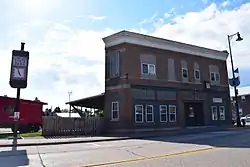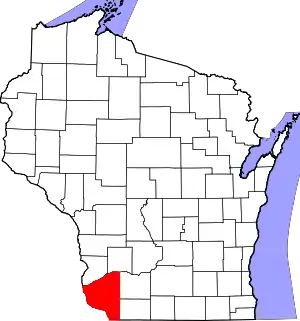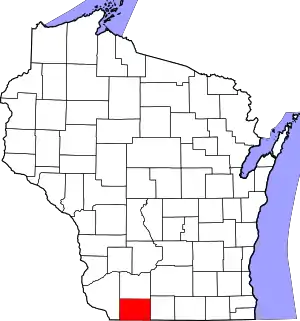Cuba City, Wisconsin
Cuba City is a city partly in Grant County and partly in Lafayette County in the U.S. state of Wisconsin. The population was 2,086 at the 2010 census. Of this, 1,877 were in Grant County, and 209 were in Lafayette County. The city is nicknamed "The City of Presidents" because of the presidential banners displayed along the city's Main Street.
Cuba City, Wisconsin | |
|---|---|
 Former Cuba City State Bank and Post Office [2] | |
| Motto(s): "The City of Presidents" | |
 Location of Cuba City in Grant County, Wisconsin. | |
| Coordinates: 42°36′21″N 90°25′49″W | |
| Country | |
| State | |
| Counties | Grant, Lafayette |
| Area | |
| • Total | 1.16 sq mi (3.00 km2) |
| • Land | 1.16 sq mi (3.00 km2) |
| • Water | 0.00 sq mi (0.00 km2) |
| Elevation | 1,010 ft (308 m) |
| Population | |
| • Total | 2,086 |
| • Estimate (2019)[6] | 2,029 |
| • Density | 1,749.14/sq mi (675.33/km2) |
| Time zone | UTC-6 (Central (CST)) |
| • Summer (DST) | UTC-5 (CDT) |
| Zip Code | 53807 |
| Area code(s) | 608 |
| FIPS code | 55-17950[7] |
| GNIS feature ID | 1563606[4] |
| Website | Cuba City, Wisconsin |
History
The history of the city began in 1836, when John Amie Merle and Mathais Comstock purchased 160 acres of land from the American Government in Grant County. The first structure in the community was erected in 1846 by Jack Deboard. Deboard is considered the first settler in Cuba City.[8]
The name "Yuba City" was finally picked after a dispute about the name of the new village, but after discovering another location had already been given that name, a new name, "Cuba City," was selected.[9][10]
The community incorporated as a village in Grant County only in 1894.[11] The village incorporated as a city in 1925[12] and annexed into Lafayette County between 1960 and 1970.
Geography
Cuba City is located at 42°36′21″N 90°25′49″W (42.605874, -90.430274).[13]
According to the United States Census Bureau, the city has a total area of 1.08 square miles (2.80 km2), all of it land.[14] Most of the city lies in Grant County, with only a small portion in Lafayette County.
The community is located on State Highway 80.
Demographics
| Historical population | |||
|---|---|---|---|
| Census | Pop. | %± | |
| 1880 | 48 | — | |
| 1900 | 636 | — | |
| 1910 | 967 | 52.0% | |
| 1920 | 1,175 | 21.5% | |
| 1930 | 1,157 | −1.5% | |
| 1940 | 1,259 | 8.8% | |
| 1950 | 1,333 | 5.9% | |
| 1960 | 1,673 | 25.5% | |
| 1970 | 1,993 | 19.1% | |
| 1980 | 2,129 | 6.8% | |
| 1990 | 2,024 | −4.9% | |
| 2000 | 2,156 | 6.5% | |
| 2010 | 2,086 | −3.2% | |
| 2019 (est.) | 2,029 | [6] | −2.7% |
| U.S. Decennial Census[15] | |||
2010 census
As of the census[5] of 2010, there were 2,086 people, 847 households, and 537 families living in the city. The population density was 1,931.5 inhabitants per square mile (745.8/km2). There were 899 housing units at an average density of 832.4 per square mile (321.4/km2). The racial makeup of the city was 99.1% White, 0.2% African American, 0.1% Native American, 0.1% Asian, and 0.5% from two or more races. Hispanic or Latino of any race were 0.5% of the population.
There were 847 households, of which 29.0% had children under the age of 18 living with them, 51.0% were married couples living together, 7.8% had a female householder with no husband present, 4.6% had a male householder with no wife present, and 36.6% were non-families. 29.4% of all households were made up of individuals, and 15.4% had someone living alone who was 65 years of age or older. The average household size was 2.36 and the average family size was 2.95.
The median age in the city was 40.9 years. 23.1% of residents were under the age of 18; 8.4% were between the ages of 18 and 24; 23.4% were from 25 to 44; 23.1% were from 45 to 64; and 21.9% were 65 years of age or older. The gender makeup of the city was 48.6% male and 51.4% female.
2000 census
As of the census[7] of 2000, there were 2,156 people, 861 households, and 569 families living in the city. The population density was 1,997.1 people per square mile (770.8/km2). There were 900 housing units at an average density of 833.7 per square mile (321.8/km2). The racial makeup of the city was 99.49% White, 0.05% Native American, 0.23% Asian, and 0.23% from two or more races. Hispanic or Latino of any race were 0.09% of the population.
There were 861 households, out of which 30.7% had children under the age of 18 living with them, 56.1% were married couples living together, 6.7% had a female householder with no husband present, and 33.9% were non-families. 29.7% of all households were made up of individuals, and 15.4% had someone living alone who was 65 years of age or older. The average household size was 2.39 and the average family size was 2.98.
In the city, the population was spread out, with 24.1% under the age of 18, 7.7% from 18 to 24, 25.6% from 25 to 44, 21.0% from 45 to 64, and 21.7% who were 65 years of age or older. The median age was 40 years. For every 100 females, there were 94.4 males. For every 100 females age 18 and over, there were 88.7 males.
The median income for a household in the city was $38,750, and the median income for a family was $46,550. Males had a median income of $30,884 versus $21,359 for females. The per capita income for the city was $19,375. About 5.9% of families and 8.8% of the population were below the poverty line, including 17.8% of those under age 18 and 4.3% of those age 65 or over.
Notable people
- Bert A. Clemens, Wisconsin State Representative, was born in Cuba City.
- Judd Conlon, music arranger for Walt Disney, was born in Cuba City.
- William H. Goldthorpe, Wisconsin State Representative, was Postmaster of Cuba City.
- Chuck Harris, NFL player, was born in Cuba City.
- Sherman E. Smalley, Wisconsin State Representative and jurist, lived in Cuba City.
- Robert S. Travis, Jr., Wisconsin State Representative, was born in Cuba City.
References
- "201-203 S Main St". Wisconsin Architecture and History Inventory. Wisconsin State Historical Society. Retrieved August 21, 2017.
- "201-203 S Main St". Wisconsin Architecture and History Inventory. Wisconsin State Historical Society. Retrieved August 21, 2017.
- "2019 U.S. Gazetteer Files". United States Census Bureau. Retrieved August 7, 2020.
- "US Board on Geographic Names". United States Geological Survey. October 25, 2007. Retrieved January 31, 2008.
- "U.S. Census website". United States Census Bureau. Retrieved November 18, 2012.
- "Population and Housing Unit Estimates". United States Census Bureau. May 24, 2020. Retrieved May 27, 2020.
- "U.S. Census website". United States Census Bureau. Retrieved January 31, 2008.
- "City History". Cuba City, Wisconsin. Archived from the original on August 15, 2012. Retrieved July 25, 2012.
- History of Cuba City Archived August 15, 2012, at the Wayback Machine
- Company, Chicago and North Western Railway (1908). A History of the Origin of the Place Names Connected with the Chicago & North Western and Chicago, St. Paul, Minneapolis & Omaha Railways. p. 61.
- History of Grant County, Wisconsin: Including Its Civil, Political, Geological, Mineralogical, Archaeological and Military History, and a History of the Several Towns. 1900. p. 741.
- "Cuba City, Wisconsin". City-Data.com. Retrieved July 25, 2012.
- "US Gazetteer files: 2010, 2000, and 1990". United States Census Bureau. February 12, 2011. Retrieved April 23, 2011.
- "US Gazetteer files 2010". United States Census Bureau. Archived from the original on January 24, 2012. Retrieved November 18, 2012.
- "Census of Population and Housing". Census.gov. Retrieved June 4, 2015.
External links
- Cuba City website
- Profile of Cuba City from the Grant County, Wisconsin website
- Additional information
- Sanborn fire insurance maps: 1900 1908

